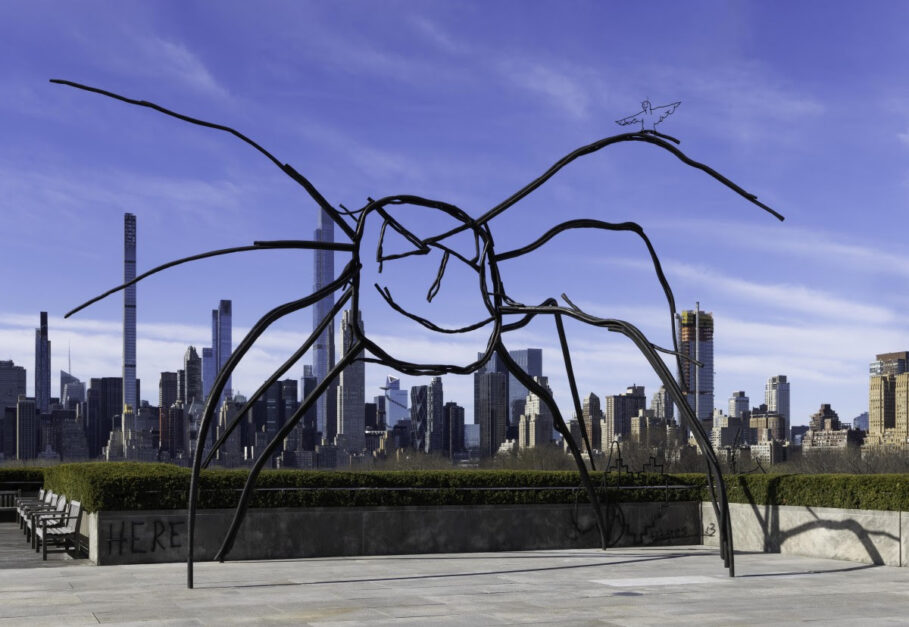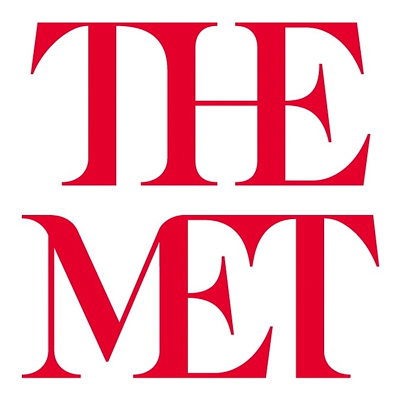The Met Unveils Petrit Halilaj’s Major Installation
for the Roof Garden Commission
~~~~~~~~~~~~~~~~~~~~~~~~~~~~~~~~~~~~~~~~

Exhibition Dates:
April 30–October 27, 2024
Exhibition Location:
The Met Fifth Avenue The Iris and B. Gerald Cantor Roof Garden, Gallery 926
———————————
The Met’s highly anticipated 2024 Roof Garden Commission, by Kosovar artist Petrit Halilaj (born 1986, Kostërc, former Yugoslavia), is now on view through October 27, 2024. For his first major outdoor installation, Halilaj has transformed the Museum’s Iris and B. Gerald Cantor Roof Garden with a sprawling work that explores the intersection of reality and fantasy through the rich world of children’s drawings. The installation’s metal sculptures are inspired by children’s doodles, drawings, and scribblings found on desks at the school he attended in Runik, Kosovo, as well as schools in Albania and countries from the former Yugoslavia, which are now undergoing significant cultural and sociopolitical change. The Roof Garden Commission: Petrit Halilaj, Abetare is the 11th in the series of site-specific commissions for the outdoor space.
The exhibition is supported by Bloomberg Philanthropies.
Additional support is provided by the Diane W. and James E. Burke Fund, Cynthia Hazen Polsky and Leon B. Polsky, and the Edward John & Patricia Rosenwald Foundation.
“The Met is thrilled to unveil Petrit Halilaj’s intervention for the Iris and B. Gerald Cantor Roof Garden and share the deeply meaningful conversation it invites between the artist’s work, the Museum, the Manhattan skyline, and beyond,” said Max Hollein, The Met’s Marina Kellen French Director and Chief Executive Officer. “Petrit Halilaj’s inspiring and multilayered work—which is both deeply rooted in the artist’s history and homeland and forward thinking and international in scope—powerfully reframes the complex role of the childhood imagination in history’s retelling of events.”
“The casual scribbles of schoolchildren done on their desks in moments of boredom or distraction reveal the fantasies and dreams of their minds,” said Halilaj. “I started to explore this in my practice in 2015, and it was important for me then to extend the dreams of my school in Kosovo to Europe, a part of the world from which my country was still isolated. Now, in 2024, numerous desks and scribbles from schools across the Balkans are showcased in a new context and on a new continent. My work here at The Met is dedicated to all the children whose lives have been interrupted and deeply scarred by wars around the globe. I hope their dreams will fly us to a better future.”
Halilaj is known for immersive installations that express a desire to alter the course of personal and collective histories, creating complex artistic worlds that claim space for freedom, intimacy, and identity. For The Met commission, furtive drawings from children’s desks have been enlarged into three-dimensional metal sculptures, with each one retaining the trace of the original drawing. Together, they bring to public view the collective memory and imaginative power of generations of students whose lives were marked by traumatic conflicts and territorial divisions. Kosovo experienced the last of a series of wars in the Balkan region in the 1990s, during which time many children were denied access to education on ideological grounds. Abetare borrows its title from the book the artist and his peers used to learn the alphabet at school, with each letter linked to a lesson in pictures and text.
The commission shares conceptual DNA with his previous body of work, the 2015 Abetare project started at Kölnischer Kunstverein, which focused on Halilaj’s research in Kosovo only. Here, by opening his project up to experiences beyond his own geographic, national, and ethnic story—across the Balkan region—he complicates binary and purely oppositional categories that pit nation against nation, or any one ideology against another, including “East” and “West”—none of which can ever fully represent the experience of the individual. Abetare at The Met creates a web between these nations and experiences through symbols and language, much like the installation’s largest sculpture, Spider, might weave a web connecting these shared experiences with the city, the Museum, and the world.
In Abetare, culturally specific references to different political ideologies, religions, and local heroes coexist with more universal symbols and playful nods to pop culture, art history, and sports. Spread around The Iris and B. Gerald Cantor Roof Garden, the “drawings in space” merge with the surrounding architecture and landscape to create a multivocal scenography with an open-ended narrative. A celebration of the shared impulse for personal expression and making a mark, Abetare is an opportunity for discovery and an invitation to expand our capacity to imagine transformative futures.
About the Artist
Petrit Halilaj is a Kosovar artist born in 1986 who endured the war in the Balkan region during the 1990s. After a formative period in Italy, where he studied art at the Accademia di Brera in Milan, he moved to Berlin in 2008, where he still lives and has his studio. His projects encompass a variety of media, including sculpture, drawing, poetry, and performance. Often incorporating material histories from his native land and manifesting as ambitious spatial installations, his work distills personal relationships, memories, and experiences into sculptural propositions.
Halilaj’s work has steadily gained international recognition over the past few years, with important exhibitions held at TBA21-Academy’s Ocean Space, Venice (2023); Tate St Ives (2021); Museo Reina Sofia, Madrid (2020); Paul Klee Zentrum, Berna (2018); Fondazione Merz, Turin (2018), New Museum, New York (2017); Hangar Bicocca, Milan (2015); Kölnischer Kunstverein, Cologne (2015); and Bundeskunsthalle, Bonn (2015). In 2013, he represented his country in the first Kosovo Pavilion at the Venice Biennale. In 2022, he participated in Manifesta 14, held in Pristina, Kosovo. In November 2023, a retrospective of his work opened at the Museo Tamayo, Mexico City.
The Roof Garden Commission: Petrit Halilaj, Abetare is conceived by the artist in consultation with Iria Candela, The Met’s Estrellita B. Brodsky Curator of Latin American Art in the Department of Modern and Contemporary Art.
The exhibition is accompanied by a publication that includes an interview between Halilaj and Candela and an essay by David Breslin, Leonard A. Lauder Curator in Charge of the Department of Modern and Contemporary Art at The Met. The publication will be available for purchase at The Met Store.
The catalogue is made possible by the Mary and Louis S. Myers Foundation Endowment Fund.
Related education programs will be posted on The Met website as they become available.
—————————

The Roof Garden Commission series was established in 2013 by The Met’s Department of Modern and Contemporary Art. The series of site-specific commissions on The Iris and B. Gerald Cantor Roof Garden has featured work by Imran Qureshi (2013), Dan Graham (2014), Pierre Huyghe (2015), Cornelia Parker (2016), Adrián Villar Rojas (2017), Huma Bhabha (2018), Alicja Kwade (2019), Héctor Zamora (2020), Alex Da Corte (2021), and Lauren Halsey (2023).
The Roof Garden Commission: Petrit Halilaj, Abetare will be featured on The Met’s website, as well as on Facebook, Instagram, and Twitter via the hashtag #CantorRoof and #MetPetritHalilaj.
————————-
==========================================================

AAQ / Resource: Ben Krupinski Builder
====================================================================

AAQ / Resource: Riverhead Toyota
_________________________________________________________

